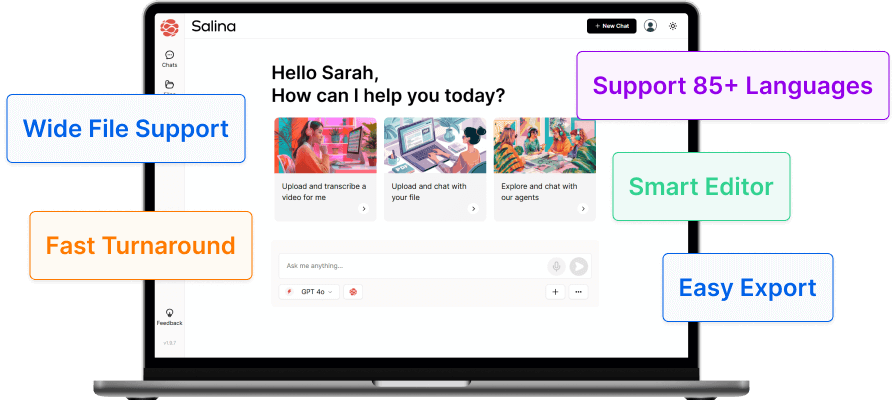Increase your content output without losing quality by learning practical ways to improve your process. Find out how to make the most of your resources and keep your audience engaged with valuable content.
When I first took on the role of the sole writer for the Salina blog, I was both excited and a bit overwhelmed. I loved the challenge of creating content that truly represented our brand, but keeping a consistent voice across all our posts was tough. I realized early on that every piece needed to have the same tone and style, which meant paying close attention to every detail.
During this time, I learned how important it was to have a clear style guide and to carefully review each piece of writing to keep things consistent. These lessons were key in helping me improve our content. However as the demand for content increased, I needed to find ways to produce more without losing quality. That’s when I discovered strategies to speed up the process, which made a big difference in my workflow.
In this blog, I’ll share the lessons I’ve learned and discuss how you can keep your brand voice consistent, even with limited resources. From setting up a clear style guide to finding efficient ways to produce content, you’ll find tips to help manage your brand’s voice across different platforms. Whether you’re working alone or with a team, these strategies will make content creation easier and more effective.
What Does Efficiently Scaling Your Content Production Process Mean?
Efficiently scaling your content production process means increasing the amount of content you produce without compromising quality or overextending resources. It’s important because it allows you to meet growing content demands across multiple channels while maintaining consistency and effectiveness. Unlike simply increasing production, efficient scaling focuses on optimizing workflows and using tools or strategies to enhance productivity and manage resources wisely.
A recent Reddit discussion raised concerns about the significance of content marketing in today’s saturated digital landscape. It raised valid concerns about whether consistent posting alone can truly drive engagement and follower growth if the content lacks real value. This perspective underscores the importance of not just increasing content volume but ensuring that each piece offers genuine value to your audience. Indeed, content marketing is still a real and vital strategy, especially when it focuses on creating content driven by its value. By delivering meaningful and relevant content, businesses can effectively engage their audiences and drive long-term success.
This aligns perfectly with my experience at Salina, where I realized that scaling content production effectively requires more than just producing more material. We needed to ensure that every piece of content was purposeful and resonated with our audience. By focusing on creating valuable and relevant content, we were able to support brand growth and demonstrate that effective content marketing is about thoughtful contributions that engage and inform.
The question now is how exactly do we do this? How do we scale valuable content and produce more from what we already have? Let’s look at a step-by-step guide to help you increase your content output without losing quality or consistency, even with limited resources.
How to Efficiently Scale Your Content Production Process: A Step-by-Step Guide
Scaling your content production doesn’t have to be overwhelming. When I started as the sole writer for Salina’s blog, I quickly realized the need for a more efficient process. By following these steps, you can increase your output while maintaining quality and consistency, even with limited resources.
1. Assess Your Current Process
Identify Bottlenecks
Analyze your workflow to find areas that slow down production. This could be time-consuming research, lengthy approval processes, or inefficient editing. Take a week to track how long each step of your content creation takes. You might find that you’re spending too much time on research or that your editing process is overly complex. Once you’ve identified these bottlenecks, you can focus on addressing them specifically.
Evaluate Resource Allocation
Determine how you’re currently using your time, tools, and team members. Look for areas where resources are underutilized or overextended. Are you spending too much time on tasks that could be automated or delegated? Are there tools you’re paying for but not fully utilizing? Create a detailed breakdown of how you allocate your resources and identify areas for improvement.
2. Develop a Content Strategy
Define Your Goals
Clearly outline what you want to achieve with your content. This could be increasing brand awareness, generating leads, or educating your audience. Be specific with your goals – for example, aim to increase website traffic by 20% in the next quarter or generate 50 new leads per month through content marketing. Having clear, measurable goals will help you focus your efforts and measure your success.
Create a Content Calendar
Plan your content topics and publishing schedule in advance. This helps maintain consistency and reduces last-minute scrambling. Use a tool like Google Calendar or a dedicated content calendar app to map out your content for at least a month in advance. Include topic ideas, target keywords, and assigned team members for each piece of content. This forward planning will help you maintain a consistent publishing schedule and ensure you’re covering a diverse range of topics.
3. Cultivate a Content Ecosystem
Encourage Cross-Functional Input
Invite input from different team members who can offer unique perspectives and ideas. This could include insights from product developers or insights from customer interactions that can inform content topics. Set up regular brainstorming sessions to gather diverse ideas that align with your brand’s goals and resonate with your audience.
Foster Community Engagement
Encourage your audience to share their experiences and stories related to your brand. Highlight customer testimonials and success stories to build trust and authenticity. Additionally, provide valuable content that addresses your audience’s needs, encouraging them to share their own work or experiences in response. This creates a sense of community and encourages organic sharing of your content. Through this sharing, you gain valuable insights into what your audience needs, appreciates, and wants more of, providing you with fresh content ideas and directions to explore.
4. Embrace Content Repurposing
Recycle Your Existing Content
Identify high-performing content and find ways to repurpose it into different formats. For example, turn a popular blog post into an infographic, podcast episode, or video. This maximizes the value of your existing content and reaches different audience segments who prefer various content types. Regularly review your content library to spot opportunities for repurposing.
Create Evergreen Content
Focus on creating content that remains relevant over time, such as how-to guides, industry best practices, or foundational knowledge pieces. Evergreen content continues to attract traffic and engagement long after it’s published, reducing the need for constant new content creation. Update these pieces periodically to ensure they remain accurate and valuable.
Creating new evergreen content isn’t the only approach; you can also identify high-performing existing content within your library and repurpose it into evergreen formats. This strategy allows you to maximize the use of content you already have, ensuring it remains relevant and engaging over time. For more insights on identifying evergreen content, check out my LinkedIn post below.
5. Build a Content Team
Delegate Tasks
If possible, bring in additional writers, editors, or designers to share the workload. This allows for specialization and increased output. Start by identifying the areas where you need the most help – perhaps you need a dedicated editor to polish your writing, or a graphic designer to create visuals for your content. Even if you can’t hire full-time team members, consider working with freelancers or part-time contractors to fill these roles. Clearly define each team member’s responsibilities to ensure smooth collaboration.
Establish Clear Guidelines
Create a comprehensive style guide to ensure all team members produce content that aligns with your brand voice and standards. Your style guide should cover elements like tone of voice, preferred writing style, formatting guidelines, and brand-specific terminology. Include examples of do’s and don’ts to make it easier for team members to understand and apply the guidelines. Regularly review and update your style guide as your brand evolves, and make sure all team members have easy access to the latest version.
While these steps offer a comprehensive guide to efficiently scaling your content production process, it’s valuable to examine real-world examples of successful content scaling strategies. One particularly noteworthy case study is Hootsuite’s approach to content repurposing, which demonstrates how effectively applying these principles can lead to remarkable success in maximizing content output and engagement. By analyzing Hootsuite’s strategy, we can gain practical insights into the implementation of content scaling techniques and their potential impact on brand performance across various platforms and audience segments.
Hootsuite’s Success in Scaling Content Production Through Repurposing
The Problem
Hootsuite, a social media management platform, needed to maintain a consistent flow of engaging content across multiple channels. With the increasing demand for diverse content types, Hootsuite needs a strategy to maximize the reach and impact of their existing content without constantly creating new material from scratch.
Action
Hootsuite adopted a robust content repurposing strategy. They transformed webinars into bite-sized YouTube videos, turned conversations with subject matter experts into blog posts, and converted digital report statistics into engaging graphics for social media. This approach allowed Hootsuite to efficiently utilize their existing content by adapting it for different audience preferences and platforms.
Result
The repurposing strategy was successful, significantly boosting Hootsuite’s content visibility and engagement while optimizing resource use. This allowed the team to focus on strategic content goals and reach various audience segments through diverse formats, enhancing overall brand engagement.
Lessons Learned
Hootsuite’s success underscores the importance of repurposing as a strategy for scaling content production efficiently. By transforming existing content into multiple formats, businesses can maximize their content’s value and reach. This approach can be applied to similar scenarios where companies aim to expand their content presence while maintaining consistency and quality.
Taking Action with Salina
Amidst the challenges of scaling your content production process efficiently, Salina emerges as a powerful ally. It ensures your content production is smooth and effective, allowing you to produce more content without sacrificing quality. By simplifying the content creation and distribution process, Salina helps brands maintain their unique voice and consistency across various platforms. This support not only enhances brand recognition but also fosters stronger connections with audiences, ultimately driving success in diverse markets. Salina’s tools and features are designed to optimize workflows, making it easier for brands to meet growing content demands while preserving the essence of their message.
How Can Salina Help You?
Boundless Content Repurposing
Salina allows you to repurpose your original content into various formats, such as blogs, social media posts, and podcasts. This feature enables you to reach different audience segments by tailoring content to suit their preferred consumption methods, thereby maximizing the utility of each piece of content you create.
Localized Content Creation
With the ability to translate and localize content in over 94 languages, Salina ensures that your message resonates with audiences around the globe. This feature is crucial for businesses looking to expand their reach internationally, as it allows for culturally relevant content that maintains brand integrity.
Efficient Production and Distribution
Salina streamlines the content creation process, allowing you to produce content up to 10 times faster than traditional methods. By automating tasks such as transcription and translation, Salina frees up your time to focus on strategic initiatives, ensuring that your content is not only prolific but also impactful.
Enhanced Content ROI
By transforming a single piece of content into multiple assets, Salina significantly increases your content’s return on investment. This approach reduces the need for constant new content creation, allowing you to focus on refining and optimizing existing content for maximum engagement and effectiveness.
Through these features of Salina, brands can effectively tackle the challenges of scaling content production. Salina boosts efficiency by enabling the creation of diverse content formats while keeping your brand’s voice consistent and engaging across all platforms. This approach helps businesses meet growing content demands without sacrificing quality, ultimately improving audience engagement and maximizing the impact of each piece of content.
Key Takeaways
- Establish a clear style guide to maintain a consistent brand voice across all content, which is essential when scaling production.
- Identify and address bottlenecks in your workflow to improve efficiency and better allocate resources.
- Develop a strategic content plan with specific goals and use a content calendar to maintain consistency and focus in your content production.
- Repurpose existing content into various formats to maximize its value and reach different audience segments, as demonstrated by Hootsuite’s success.
- Use tools like Salina to simplify content creation and distribution, enabling efficient scaling without sacrificing quality.
What’s Next
As we look to the future of scaling content production, it’s important to remain adaptable and proactive in your approach.
Embrace strategies that prioritize both quality and efficiency, ensuring that your content continues to meet the evolving needs of your audience.
Explore new tools and technologies that simplify content creation and distribution, allowing you to focus on strategic growth.
Keep an eye on trends in content consumption, such as video and interactive media, to engage audiences effectively. By fostering a culture of innovation and continuously refining your processes, you can meet future content demands and seize new opportunities for growth.




